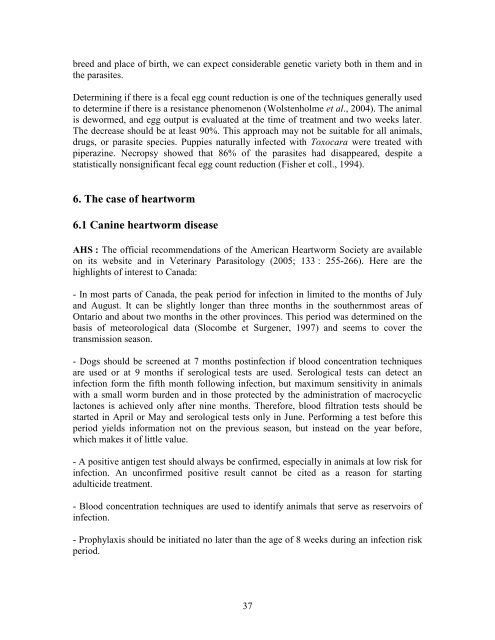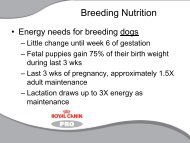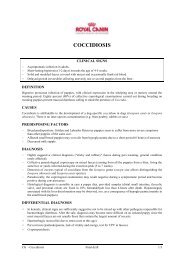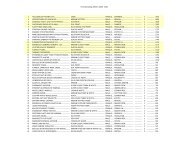Guide to Preventing Parasites.pdf - Royal Canin Canada
Guide to Preventing Parasites.pdf - Royal Canin Canada
Guide to Preventing Parasites.pdf - Royal Canin Canada
Create successful ePaper yourself
Turn your PDF publications into a flip-book with our unique Google optimized e-Paper software.
eed and place of birth, we can expect considerable genetic variety both in them and in<br />
the parasites.<br />
Determining if there is a fecal egg count reduction is one of the techniques generally used<br />
<strong>to</strong> determine if there is a resistance phenomenon (Wolstenholme et al., 2004). The animal<br />
is dewormed, and egg output is evaluated at the time of treatment and two weeks later.<br />
The decrease should be at least 90%. This approach may not be suitable for all animals,<br />
drugs, or parasite species. Puppies naturally infected with Toxocara were treated with<br />
piperazine. Necropsy showed that 86% of the parasites had disappeared, despite a<br />
statistically nonsignificant fecal egg count reduction (Fisher et coll., 1994).<br />
6. The case of heartworm<br />
6.1 <strong>Canin</strong>e heartworm disease<br />
AHS : The official recommendations of the American Heartworm Society are available<br />
on its website and in Veterinary Parasi<strong>to</strong>logy (2005; 133 : 255-266). Here are the<br />
highlights of interest <strong>to</strong> <strong>Canada</strong>:<br />
- In most parts of <strong>Canada</strong>, the peak period for infection in limited <strong>to</strong> the months of July<br />
and August. It can be slightly longer than three months in the southernmost areas of<br />
Ontario and about two months in the other provinces. This period was determined on the<br />
basis of meteorological data (Slocombe et Surgener, 1997) and seems <strong>to</strong> cover the<br />
transmission season.<br />
- Dogs should be screened at 7 months postinfection if blood concentration techniques<br />
are used or at 9 months if serological tests are used. Serological tests can detect an<br />
infection form the fifth month following infection, but maximum sensitivity in animals<br />
with a small worm burden and in those protected by the administration of macrocyclic<br />
lac<strong>to</strong>nes is achieved only after nine months. Therefore, blood filtration tests should be<br />
started in April or May and serological tests only in June. Performing a test before this<br />
period yields information not on the previous season, but instead on the year before,<br />
which makes it of little value.<br />
- A positive antigen test should always be confirmed, especially in animals at low risk for<br />
infection. An unconfirmed positive result cannot be cited as a reason for starting<br />
adulticide treatment.<br />
- Blood concentration techniques are used <strong>to</strong> identify animals that serve as reservoirs of<br />
infection.<br />
- Prophylaxis should be initiated no later than the age of 8 weeks during an infection risk<br />
period.<br />
37







